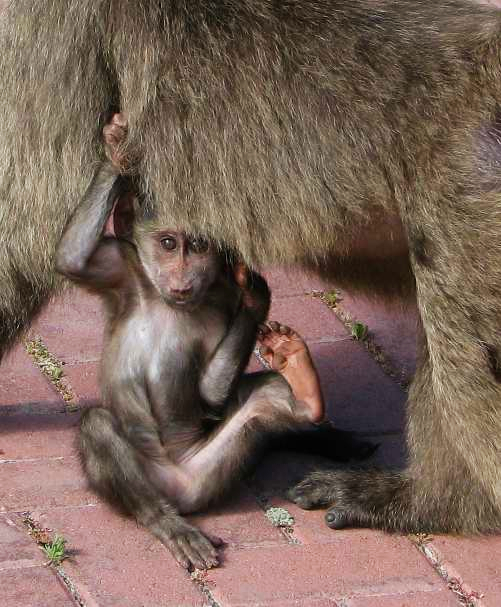
In 2009, the Peninsula's small and already endangered free-ranging baboon population that had shown little increase over 350 in around a dozen troops during the last decade, came under further threat due to new strategies including a culling protocol introduced in August 2009.
The "action plan for dispersing males and repeat raiders" initially targeted healthy young mature males leaving the troop as a result of dominance fighting and in the process coming into the urban area and "raiding" or eating human derived food.
The controversial protocol, sparking outrage among people across the world, was introduced one month after changed management in July that occurred amidst allegations of a flawed process.
An additional even further reaching protocol adopted on 18 June 2010 targeted "individual raiders"- even though any baboon given the opportunity will eat available food or "raid".
While described as an "improvement", having mitigating circumstances before culling, this protocol was in fact more extensive, targeting other categories including age, gender or certain troops such as fission troops, described in 2009 as the result of a male successfully "dispersing" or leaving the troop and starting his own troop. In 2012, the fission troop was suddenly redefined as a 'splinter troop', a supposedly 'low quality' troop formed specifically to raid.
This change of definition preceded an an attempt to "remove" a fission troop like the Da Gama Park troop by killing the two males. The troop was formed in 2008 following fierce fighting between alpha male, George and the young male Peter who left the troop with three females. By 2012 the troop was comprised of around a dozen members with males Peter and Carpenter, three females and young.
Despite efforts to merge the troops, the females refused to join the main troop after the males' culling - instead, a new male, Horace, from the neighbouring Slangkop troop moved in and became alpha male.
The second protocol was not made available to the public with the reason that some residents could use it against the baboons as it allowed for the to make affadavits that could be used as supporting evidence when motivating for the 'selective removal' of a baboon. (The protocol was made public a year later.) The two protocols are seen in effect as attempting to over-ride the baboons' legally protected status.
The first baboon killed in terms of this protocol, on 2 July 2010, alpha male, WiIliam of Scarborough, was trapped and lethally darted. Residents who saw him being trapped were told the batteries in his tracking collar were being changed. Residents have complained about the lack of transparency regarding what happens to the baboons and the difficulty in getting answers to even factual questions.
Fred, the alpha male of the Smitswinkel troop, was killed on 23 March 2011 despite public objections on the day, including that he was the alpha male, a mitigating circumstance against culling.
It was claimed he had an ability to open car doors and enter vehicles where people were, although other baboons also are able to do so, making locking cars doors essential - not merely shutting them - when parked along areas of the scenic coastline that baboons frequent. (Other baboons, including Merlin, the grandfather of the troop are also able to open car doors.)
Signposts warn tourists to keep cars locked and windows closed.
More baboons were subsequently culled. BRU recommended contraception for the Da Gama troop and castration was introduced. (Both males known to be castrated, were later culled.)
In June 2012, attempts were made to trap Merlin and Force, adult males of the Smitswinkel troop in order to cull them. (Force would subsequently die in May 2013, after he failed to wake up from a routine procedure to change the batteries in his collar.)
Conservationists and people locally and internationally have long been concerned about the future of the free-ranging baboons on the Peninsula, there since before human settlement.
However, concerns are Increasingly expressed that baboon management strategies are moving away from tolerating them occasionally passing through the urban area (given their natural habitat is encroached on by urbanisation) to strategies unwilling to tolerate them even passing through urban areas and as opportunistic feeders eating human derived food, with protocols in place that essentially allow baboons to be culled for doing so. Entering a vehicle or property in search of food, even though unlocked, counts against them, particularly so if occupied.
In 2012 the head of the baboon research unit also advocated using pain aversion tools like paintballs to chase baboons as his interim plan, with electric fencing erected around all baboon affected areas as his long term solution.
Paintballing was introduced into all eleven managed troops starting in July 2012 (a BRU researcher was contracted for a month to help oversee the process). The newly appointed service provider, HWS also headed by a scientist, began operating in August 2012. (SOPs gave permission for paintballs, pepperballs and pepperspray and allowed for rubber balls and plastic balls to be used.)
Residents - and monitors who were subsequently fired - were upset and outraged when seeing the paintballing in action. However, their objections and concerns were ignored. Baboons deemed resistant to pain aversion tools are killed.
Since 2009 around 51 baboons have been killed in terms of protocols with around 43 since 2012.
For more also visit : capechacmababoons.yolasite.com